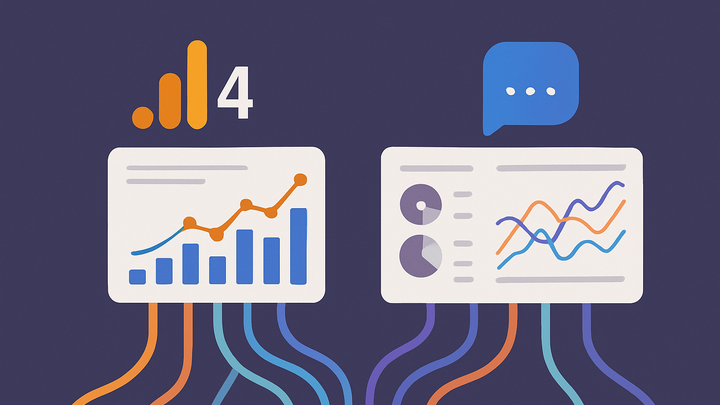Published on 2025-06-26T04:46:57Z
What is Data Aggregation? Examples in Analytics
Data Aggregation in analytics refers to the process of collecting, organizing, and summarizing large volumes of raw event-level data into meaningful, high-level metrics. As users interact with websites and apps, platforms such as Google Analytics 4 (GA4) or PlainSignal capture individual events—pageviews, clicks, sessions—and channel them through tracking scripts or SDKs. Data aggregation consolidates these granular records by dimension (such as time period, geography, device type, or user segment) and applies summary functions (count, sum, average) to deliver actionable insights. By reducing data complexity and volume, aggregation supports faster querying, streamlined reporting, and compliance with privacy regulations. Businesses leverage aggregated data to monitor performance, identify trends, and make informed decisions without handling unwieldy datasets or exposing personal-level details. Proper aggregation design also ensures data integrity and consistency across analytics workflows, empowering stakeholders with reliable metrics.
Data aggregation
Collecting and summarizing raw analytics events into high-level metrics for reporting and insights in tools like GA4 and PlainSignal.
Importance of Data Aggregation
Aggregating data is essential in analytics for transforming detailed event logs into digestible metrics. This process helps ensure scalability, reduces query complexity, and aligns with privacy regulations by summarizing identifiable details. Well-designed aggregation pipelines allow businesses to quickly access key performance indicators (KPIs) and make data-driven decisions from high-level trends rather than sifting through raw records.
-
Improved scalability and performance
By summarizing raw data at ingest or storage time, aggregation reduces the volume of records processed in real-time queries, leading to faster dashboard load times and lower infrastructure costs.
-
Storage efficiency
Aggregating data minimizes storage requirements by compressing granular events into summary tables.
-
Faster queries
Pre-computed aggregates enable report and dashboard queries to execute quickly, even over large datasets.
-
-
Enhanced data privacy
Aggregated data inherently abstracts individual behaviors, helping organizations comply with regulations like GDPR and CCPA by minimizing personally identifiable information exposure.
-
Anonymization
Summaries prevent tracing data back to individual users.
-
Compliance
Aggregation supports privacy standards by limiting the detail of stored analytics.
-
-
Actionable insights
High-level metrics like total sessions or average time on page reveal overall performance trends, enabling stakeholders to spot anomalies and drive strategic optimizations.
-
Trend analysis
Aggregated time-series data makes it easy to identify upward or downward trends over time.
-
Segmentation
Grouping aggregated data by dimensions—such as geography or device—unlocks deeper audience insights.
-
Common Aggregation Techniques
Analytics platforms offer various methods to roll up and filter data, each suited for particular reporting needs. Understanding these techniques helps in designing efficient data pipelines.
-
Roll-up and drill-down
Roll-up operations combine data across hierarchies (e.g., site → page), while drill-down allows users to investigate underlying details when needed.
-
Roll-up
Summarizes data from fine-grained levels to broader categories.
-
Drill-down
Enables exploration from summarized metrics back to raw event data.
-
-
Summarization functions
Common functions include COUNT, SUM, AVERAGE, MIN, and MAX, which provide different perspectives on aggregated datasets.
-
Count
Calculates the number of events or records in a group.
-
Sum
Totals the values within a grouped dimension.
-
Average
Determines the mean value of a metric across a set.
-
-
Sampling and filtering
When dealing with extremely large volumes, sampling or filtering techniques ensure manageable data sizes, though they can introduce bias if not carefully applied.
-
Sampling methods
Applies statistical sampling to select representative subsets of data.
-
Filtering criteria
Uses conditions to include only relevant records for aggregation.
-
Examples with SaaS Analytics Tools
Different analytics platforms implement aggregation pipelines in unique ways. The following examples illustrate how PlainSignal and Google Analytics 4 collect and summarize data for reporting.
-
PlainSignal cookie-free aggregation
PlainSignal employs a lightweight, cookie-free script to capture user interactions and aggregates data on its servers into metrics like pageviews, visits, and bounce rates.
-
Integration snippet
<link rel="preconnect" href="//eu.plainsignal.com/" crossorigin /> <script defer data-do="yourwebsitedomain.com" data-id="0GQV1xmtzQQ" data-api="//eu.plainsignal.com" src="//cdn.plainsignal.com/plainsignal-min.js"></script> -
Aggregated metrics
Out-of-the-box metrics include total visits, unique visits, average time on site, and pageview counts without relying on cookies.
-
-
Google analytics 4 aggregation
GA4 uses the gtag.js library to collect event-level data, then processes logs into aggregated reports based on sessions, user properties, and events.
-
Gtag.js integration
<script async src="https://www.googletagmanager.com/gtag/js?id=G-XXXXXXX"></script> <script> window.dataLayer = window.dataLayer || []; function gtag(){dataLayer.push(arguments);} gtag('js', new Date()); gtag('config', 'G-XXXXXXX'); </script> -
Reporting api
GA4’s Data API provides access to aggregated metrics and dimensions for custom dashboards and BI tools.
-
Best Practices for Data Aggregation
Adhering to best practices ensures that aggregated data remains reliable and actionable across analytics workflows.
-
Define clear aggregation levels
Establish and document which timeframes and dimensions should be aggregated (e.g., hourly, daily, by country) to maintain consistency.
-
Time-based levels
Decide on appropriate intervals like hourly, daily, or weekly based on reporting needs.
-
Dimensional levels
Select which dimensions—such as device or region—are relevant for aggregation.
-
-
Monitor data quality
Regularly validate aggregated metrics against raw data samples to detect discrepancies or data loss.
-
Quality checks
Implement automated tests to compare aggregates with expected values.
-
-
Balance granularity and performance
Avoid overly fine-grained aggregation that can degrade performance; choose summary levels that serve business questions without overloading systems.
-
Performance tuning
Adjust aggregation intervals and summary levels based on query patterns and system capabilities.
-
Challenges and Limitations
While aggregation simplifies analysis, it also introduces potential drawbacks that teams must consider.
-
Loss of granularity
Aggregated data may hide important variations or outliers present in raw records.
-
Sampling bias
Using sampling to reduce data volume can distort insights if samples are not representative of the full dataset.
-
Scalability constraints
Extremely high-volume environments may still face performance bottlenecks during real-time aggregation updates.
